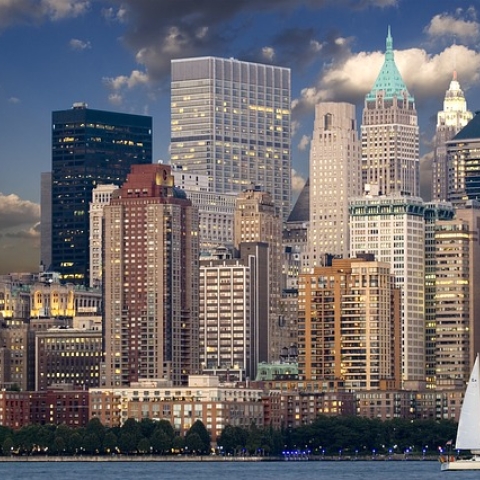Event Planners Tell How to Take a Bite Out of the Big Apple

New York. The city that never sleeps. The city that crams 3.9 million people into Manhattan’s 23 square miles on any given weekday. It can pose more than a few logistical challenges for corporate event planners, but at the same time, can open the doors for truly unique event experiences.
I spoke with several veteran New York City independent event planners, who shared some best practices for overcoming the challenges that make planning corporate events in New York a unique experience.
Finding and booking the right meeting venue is a challenge for most planners, but this can be particularly difficult in the boroughs of New York City.
Andrea Freeman of Andrea Freeman Events said it's never too early to book your venue and hotel space.
“It may seem like New York is a vast ocean of venues, but when you fully assess your event needs there are usually just a few that check all the boxes,” Freeman explained.
She added, “Between that and a huge number of organizations vying for the same spaces I can't stress enough how important it is to book in advance. This goes double for hotel blocks!”
Karen Shackman of Shackman Associates New York recommends taking the time to find a venue that fits your attendees' style and culture.
“In a city like New York, there are so many options for event venues, decor, menus, entertainment and vibe, it is important to understand what will resonate with attendees - cookie-cutter doesn't work anymore” said Shackman.
Amy Williams, executive producer at The XD Agency, believes that the most challenging part of planning corporate events in New York is the lack of venues in midtown that can accommodate audiences larger than a few hundred people.
“Other key challenges include restrictive city permitting, load-in challenges/lack of parking for trucks, constant construction, congested sidewalks, expensive housing for crew, general security concerns and, in many cases, old buildings that lack modern amenities such as elevator access and adequate power,” Williams added.
One way to bring diverse attendees together is through food.
Shackman stated, “With food, you really can please everyone. One creative way to do this is to hold events at evocative, open-space venues where planners can import chefs to prepare personalized, locally-sourced dining options such as art galleries in the city's trendiest neighborhoods”.
Shackman has also found that neighborhood experiences are huge for millennial attendees in particular.
“Today's attendee wants to experience what it's like to be a real New Yorker and many locations can accommodate that,” she said. “The hottest neighborhood right now is the Lower East Side, where many top mixologists have opened venues that are ideal for after-hours events.”
Another tip: when you can’t find it on land, take to the water with customized events.
“In New York, the key to planning a water event is understanding how it differs from the usual tourist experience. We recently did a 10-boat flotilla from Midtown Manhattan to the Statue of Liberty where attendees enjoyed a private fireworks show,” said Shackman.
Transportation is another major area of concern in New York. Experts emphasize the importance of being super-organized with transportation.
“Be prepared with alternate routes to event destinations within New York, and work with a local DMC that has contacts throughout city agencies to help attendees minimize traffic and parking challenges that can arise out of nowhere,” Shackman advised.
Freeman recommended hiring outside support to ease the burden.
“Hire a great transportation company if you need to move people around the city,” she said. “It takes a really skilled team to juggle all the pieces when it comes to staging buses on crowded city streets and needs to be timed to the minute!”
She also suggested to plan for delays, “When organizing travel for keynotes build in a large cushion for delay. If a speaker is coming directly from the airport on a weekday morning, plan two and a half hours for their travel. You can always count on traffic delays in the city.”
Our experts offered a few final considerations for planning in the city.
According to Shackman, branding can make or break an event in many ways.
“In New York City, planners need to know that branding conflicts can occur everywhere,” she explained. “We had to relocate a rooftop event because there was a billboard advertising a competitor within eyesight of the event's location. Leverage the inside knowledge of a local DMC to get the information you need to avoid branding problems.”
Additionally, load-in and strike must be timed and efficient.
“Because most venues in New York City have limited space you generally need to load-in and strike all on event day,” said Freeman. “This can be tricky so I recommend scheduling "exact time" drops and pickups with rental companies.”
If you’re looking for new frontiers for incentives or spouse programs, Shackman recommends private shopping experiences.
“We’ve run private shopping experiences for meeting attendees at stores like Saks Fifth Avenue or in designer showrooms,” she said. “However, we are seeing that pop-up shops from major celebrities are even bigger draws.”
While New York City planning may present challenges, these planners wouldn’t have it any other way.
“Ultimately, the upside of planning in New York is its phenomenal catering, décor and production resources,” said Williams. “Overcoming the challenges takes a combination of experience, patience and adequate planning – but in the end, it’s all worthwhile.”
Don't miss any event news: sign up for our weekly e-Newsletter HERE & engage with us on Twitter, Facebook, LinkedIn & Instagram!


Add new comment